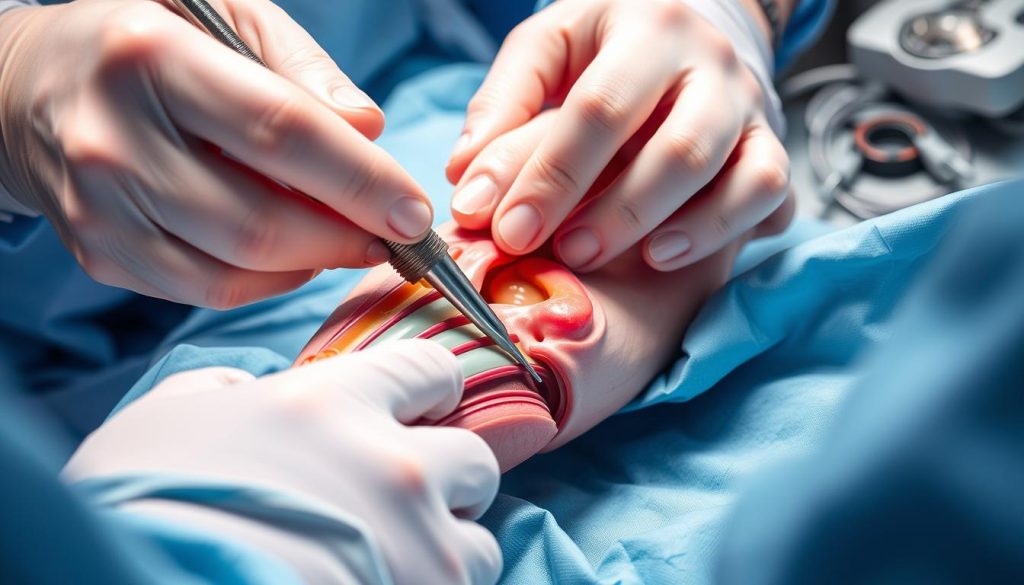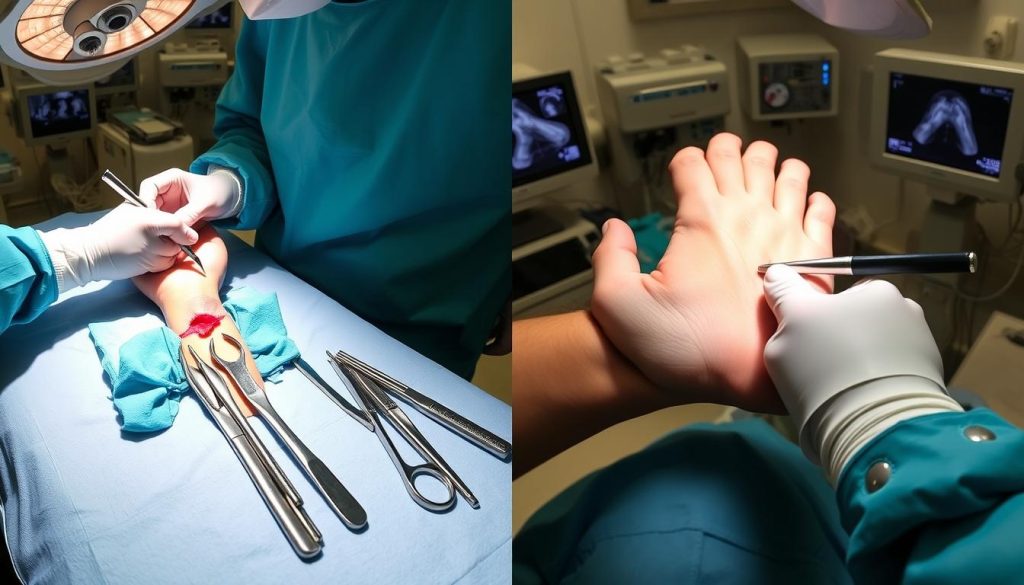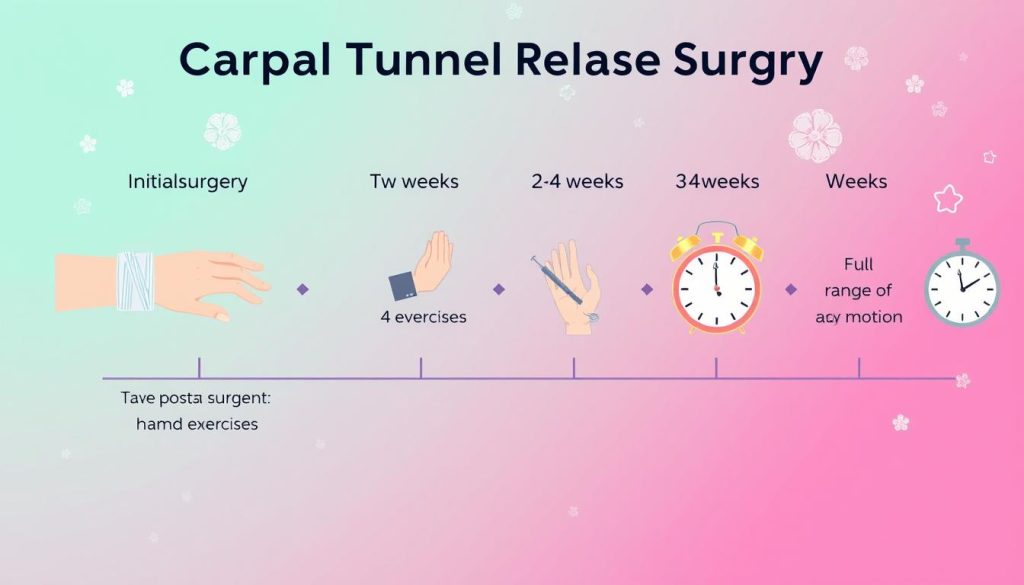Carpal tunnel syndrome surgery is a common treatment for wrist pain and numbness. It’s also known as carpal tunnel release. This surgery aims to ease pressure on the median nerve in the wrist. Many people wonder what the surgery is like and how it will change their daily life.
In this surgery, a surgeon cuts the ligament that’s pressing on the nerve. This makes more room in the carpal tunnel, helping symptoms like tingling and hand weakness. The whole procedure usually takes less than an hour and can be done without staying overnight in the hospital. Most people see a big improvement in their symptoms after they recover.
Knowing what to expect before, during, and after surgery can make things less scary. From tests before surgery to care after, each step is important for success. Let’s look at what carpal tunnel release means for those looking to relieve their symptoms.
Understanding Carpal Tunnel Syndrome Surgery
Carpal tunnel syndrome can really mess up your daily life. If other treatments don’t work, surgery might be the next step. Let’s look at the different surgeries, why they’re needed, and what you can expect.
Types of Surgical Procedures
There are two main surgeries for carpal tunnel: open and endoscopic. Open surgery needs a bigger cut in your palm. Endoscopic surgery uses tiny cuts and a camera. Both surgeries aim to ease pressure on the median nerve.

When Surgery Becomes Necessary
Surgery is usually suggested when:
- Symptoms last more than 6 months
- Other treatments don’t help
- You have nerve damage or muscle weakness
- Everyday tasks are really hard
Success Rates and Outcomes
Surgery for carpal tunnel is very effective. Most people see big improvements in their symptoms and hand function. How long it takes to get back to normal varies, but many people are back in a few weeks to months.
| Procedure | Success Rate | Recovery Time |
|---|---|---|
| Open Surgery | 90-95% | 4-8 weeks |
| Endoscopic Surgery | 85-90% | 2-4 weeks |
Knowing these details can help you decide the best treatment for carpal tunnel syndrome.
Preparing for Your Carpal Tunnel Release Surgery
Getting ready for carpal tunnel release surgery is a big step. Your doctor will help you through it. You’ll need to go through medical checks, change your meds, and make lifestyle changes.
Medical Evaluations and Tests
Before surgery, you’ll have to go through some tests. These include:
- Physical examination of your hand and wrist
- Nerve conduction studies
- Blood tests to check your overall health
- Imaging tests like X-rays or MRI scans

Medication Adjustments
Your surgeon will look at your meds and might suggest changes:
| Medication Type | Action Required | Timeframe |
|---|---|---|
| Blood thinners | Stop or reduce | 7-10 days before surgery |
| NSAIDs | Stop | 1 week before surgery |
| Herbal supplements | Stop | 2 weeks before surgery |
Lifestyle Changes Before Surgery
To help with recovery, make these lifestyle changes:
- Quit smoking to enhance healing
- Eat a balanced diet rich in vitamins and minerals
- Exercise regularly to improve overall health
- Arrange for help at home during your recovery period
By taking these steps, you’re preparing for a successful surgery and a smoother recovery.
Open vs. Endoscopic Surgical Techniques
Carpal tunnel syndrome surgery has two main types: open and endoscopic. Each has its own benefits and things to consider.

Open carpal tunnel surgery needs a bigger cut in the palm, about 2 inches. It lets surgeons see the carpal ligament and other areas clearly. But, it takes longer to heal and might be better for harder cases.
Endoscopic carpal tunnel surgery uses tiny cuts and a camera. It heals faster and hurts less after. Yet, it needs special tools and might not work for everyone.
| Aspect | Open Surgery | Endoscopic Surgery |
|---|---|---|
| Incision Size | 2 inches | 0.5-1 inch |
| Recovery Time | 4-6 weeks | 2-4 weeks |
| Scarring | More visible | Less visible |
| Surgical View | Direct | Camera-assisted |
Your doctor will pick the best method for you. It depends on your condition, health, and lifestyle. Both ways can help many people feel better from carpal tunnel syndrome.
The Day of Your Surgery: Step-by-Step Process
Knowing what to expect on the day of your carpal tunnel syndrome surgery can ease anxiety and help you prepare. Let’s walk through the key steps of your surgical journey.
Arrival and Check-in Procedures
When you arrive at the hospital or surgical center, head to the registration desk. Bring your ID, insurance card, and any pre-surgery paperwork. Wear loose, comfortable clothing that’s easy to remove. You’ll change into a hospital gown and meet with your care team.
Anesthesia Administration
Your anesthesiologist will discuss the type of anesthesia for your hand and wrist surgery. Options may include local, regional, or general anesthesia. They’ll explain the process and address any concerns you may have.

Operating Room Protocol
In the operating room, the surgical team will position you for the procedure. They’ll clean and prep your hand for carpal tunnel syndrome surgery. The surgeon will perform the operation, which typically takes 15-30 minutes per hand.
| Stage | Duration | Key Actions |
|---|---|---|
| Check-in | 30-60 minutes | Registration, change clothes, meet care team |
| Pre-op | 30-45 minutes | Anesthesia consultation, final prep |
| Surgery | 15-30 minutes per hand | Carpal tunnel release procedure |
| Recovery | 1-2 hours | Wake up, initial monitoring |
Understanding these steps can help you feel more at ease as you prepare for your carpal tunnel syndrome surgery. Remember, your surgical team is there to support you throughout the process.
Recovery Timeline After Hand and Wrist Surgery

Recovering from carpal tunnel release surgery is a journey with milestones. Each person heals differently, but a general timeline helps set expectations. Knowing this journey is key for those going through hand and wrist surgery.
In the first week, rest and wound care are top priorities. The bandage stays on, and stitches are in place. Pain and swelling are common. Most people go home the same day as their surgery.
Weeks two to four bring big steps forward. Stitches get removed, and some hand function returns. Light activities are okay, but heavy lifting is a no-go. Driving might be allowed, depending on the surgeon’s say-so and which hand was operated on.
By the second month, many can go back to work, even with desk jobs. But those in tough jobs might need more time. Physical therapy starts here to boost hand strength and flexibility.
| Recovery Phase | Milestones |
|---|---|
| Week 1 | Rest, wound care, pain management |
| Weeks 2-4 | Stitch removal, light activities, possible driving |
| Months 2-3 | Return to work, physical therapy begins |
| Months 3-6 | Gradual return to normal activities |
It can take up to six months to fully recover from hand and wrist surgery. During this time, activities gradually return to normal. Regular check-ups with the surgeon are vital for healing and addressing any issues.
Post-Operative Care and Management
After carpal tunnel release surgery, it’s important to follow your doctor’s care instructions. This helps your body heal well. Here’s what you can expect during your recovery.
Pain Management Strategies
Controlling pain after surgery is vital for a smooth recovery. Your doctor might give you pain medicine or suggest over-the-counter options. Using ice packs can help with swelling and numbness.
Also, keeping your hand above your heart can reduce pain and swelling.
Wound Care Instructions
Good wound care is key to avoiding infection and helping your wound heal. Make sure the surgical area stays clean and dry. Follow your surgeon’s instructions for changing dressings.
Watch for any signs of infection, like more redness, warmth, or discharge.
Activity Restrictions
It’s important to follow activity guidelines to protect your healing wrist. For a few weeks, avoid heavy lifting and hard activities. Your doctor might suggest gentle hand exercises to prevent stiffness.
They will tell you when it’s okay to go back to normal activities.
| Recovery Phase | Pain Management | Wound Care | Activity Level |
|---|---|---|---|
| First Week | Prescription pain meds, ice packs | Keep bandage dry, change as directed | Rest hand, minimal movement |
| Weeks 2-4 | OTC pain relievers as needed | Remove stitches, keep incision clean | Begin light activities, avoid heavy lifting |
| Weeks 5-8 | As needed for comfort | Monitor for healing progress | Gradually increase hand use, start therapy |
Physical Therapy and Rehabilitation Exercises
After carpal tunnel release surgery, physical therapy is key to recovery. Patients start gentle exercises a few days after surgery. These help with healing and getting the hand and wrist to work right again.
- Tendon gliding exercises
- Nerve gliding techniques
- Grip strengthening activities
- Wrist flexion and extension movements
At first, patients do simple things like making a fist or touching each finger to the thumb. As they get better, they do more complex things. This helps the healing tissues and gets the hand and wrist working fully.
There are many good things about rehab after hand and wrist surgery:
| Benefit | Description |
|---|---|
| Reduced scar tissue | Regular movement prevents excessive scarring |
| Improved circulation | Exercises increase blood flow to the surgical site |
| Enhanced strength | Targeted activities rebuild muscle power |
| Restored dexterity | Fine motor skills improve through specific exercises |
A physical therapist helps patients with these exercises, changing the plan as needed. They make sure patients do the exercises right to avoid injury. With hard work in rehab, most people see big improvements in their hand function and overall life quality.
Potential Risks and Complications
Carpal tunnel syndrome surgery has risks, like any medical procedure. Complications are rare, but knowing them is key. This knowledge helps patients decide wisely about their surgery.
Common Side Effects
After surgery, you might feel:
- Temporary numbness or tingling
- Mild pain at the incision site
- Swelling in the hand or wrist
- Stiffness in the fingers
Warning Signs to Watch For
Some signs might mean a problem:
- Excessive bleeding or oozing from the wound
- Severe pain not relieved by medication
- Signs of infection (redness, warmth, fever)
- Persistent numbness or weakness
When to Contact Your Doctor
If you see any warning signs, call your surgeon. It’s wise to get medical advice if unsure. Quick action can avoid complications and aid in a smooth recovery.
| Complication | Frequency | Action |
|---|---|---|
| Nerve damage | Less than 1% | Immediate medical attention |
| Infection | 1-2% | Antibiotics, wound care |
| Scar sensitivity | 5-10% | Desensitization techniques |
| Pillar pain | 10-15% | Physical therapy, pain management |
Returning to Daily Activities and Work
After carpal tunnel release surgery, many wonder when they can go back to normal. Recovery times differ, but most can start doing daily tasks in a few weeks.
In the first week, rest and healing are key. Stay away from heavy lifting and hard hand movements. You might need help with simple tasks like getting dressed or cooking.
By week two, you can start with light activities and taking care of yourself.
When you can go back to work depends on your job. Office jobs might allow you to return in 1-2 weeks. But, jobs that require manual labor could take 4-8 weeks. Talk to your surgeon about your job to plan a safe return.
- Light typing: 1-2 weeks
- Driving: 1-2 weeks (once off pain medication)
- Household chores: 2-4 weeks
- Heavy lifting: 6-8 weeks
Workplace changes might be needed during recovery. This could include ergonomic changes, fewer hours, or different tasks. Talk to your employer about your needs after surgery to smoothly get back to work.
“Listen to your body and don’t rush the healing process. A gradual return to activities after carpal tunnel release surgery promotes better long-term outcomes.”
It’s important to follow your surgeon’s post-operative instructions. This is key for a successful recovery and getting back to normal activities.
Long-term Outcomes and Success Rates
Carpal tunnel syndrome surgery brings lasting relief to many. Studies show high success rates. Most people see big improvements in symptoms after the surgery.
Quality of Life Improvements
After carpal tunnel release, patients often notice:
- Less pain and numbness in hands
- Stronger grip
- Better sleep
- More ability to do daily tasks
A survey found 85% of patients were happy with their results five years after surgery. Many went back to activities they couldn’t do because of pain.
Prevention of Recurrence
While carpal tunnel release works well, preventing it from coming back is key. To keep your quality of life good, you can:
- Use proper ergonomics at work
- Take breaks during repetitive tasks
- Do hand-strengthening exercises
- Wear wrist splints at night if needed
By doing these things, most patients stay symptom-free for a long time after surgery. Regular check-ups with your doctor help keep things on track.
| Timeframe | Symptom Improvement | Patient Satisfaction |
|---|---|---|
| 6 months post-surgery | 70% | 80% |
| 1 year post-surgery | 85% | 90% |
| 5 years post-surgery | 90% | 85% |
Alternative Treatments and Conservative Options
Before looking into surgery for carpal tunnel syndrome, many try non-invasive treatments. These methods can help and might stop surgery from being needed.
Wearing a wrist splint at night is a common start. It keeps the wrist straight, easing pressure on the median nerve. Exercises in physical therapy can also help. They make the wrist and hand muscles stronger, improving movement and easing pain.
Corticosteroid injections can also help by reducing swelling around the median nerve. They work for a few months but long-term use can have side effects.
Making lifestyle changes is key in managing carpal tunnel syndrome. Adjusting workspaces, taking breaks, and keeping good posture can lessen wrist strain.
For conditions like cubital tunnel syndrome and trigger finger, similar non-surgical methods are used. While surgery might be needed for severe cases, these options are tried first.
| Treatment | Carpal Tunnel Syndrome | Cubital Tunnel Syndrome | Trigger Finger |
|---|---|---|---|
| Splinting | Wrist splint | Elbow brace | Finger splint |
| Exercises | Wrist stretches | Nerve gliding exercises | Finger flexibility exercises |
| Injections | Corticosteroid | Corticosteroid | Corticosteroid |
Many find relief without surgery by trying these non-surgical methods. But if symptoms don’t get better or get worse, surgery might be needed.
Cost and Insurance Coverage Considerations
It’s important for patients to understand the costs of carpal tunnel syndrome surgery. The price can change based on where you are, the surgeon’s skill, and the facility’s fees.
Insurance Documentation
Most insurance plans cover carpal tunnel surgery if it’s needed. You should collect these documents:
- Detailed medical history
- Diagnostic test results
- Records of any treatments tried first
- A letter from your surgeon saying surgery is needed
Send these to your insurance for approval before surgery. This can help you avoid surprise costs.
Payment Plans and Options
If you don’t have insurance or have a high deductible, many places offer payment plans:
| Payment Option | Description | Typical Terms |
|---|---|---|
| In-house financing | Direct payment plan with the surgical center | 0-12% interest, 12-24 months |
| Medical credit cards | Specialized credit for healthcare expenses | 0% intro APR, 6-24 months |
| Health savings accounts (HSA) | Tax-advantaged savings for medical costs | Pre-tax contributions, no interest |
Talk to your healthcare provider about these options. They can help you find the best way to pay. Remember, surgery can greatly improve your life and work.
Choosing the Right Hand Surgeon
Finding a skilled surgeon for your hand and wrist surgery is key. For carpal tunnel release, look for a specialist with lots of experience. Board certification in hand surgery shows they know their stuff.
Check the surgeon’s credentials and what patients say about them. A good doctor should have lots of positive feedback and successful cases. Make sure to ask about their experience with carpal tunnel syndrome.
At your consultation, ask about their carpal tunnel release approach. Find out their techniques, success rates, and possible complications. A great surgeon will explain everything clearly and answer your questions.
- Years of experience in hand and wrist surgery
- Number of carpal tunnel release procedures performed annually
- Complication rates and patient satisfaction scores
- Availability for follow-up care and support
Think about how well the surgeon communicates. You should feel at ease talking about your symptoms and treatment. A surgeon who listens well and explains things clearly makes a big difference.
| Factor | Importance |
|---|---|
| Board Certification | High |
| Experience with Carpal Tunnel Release | Critical |
| Patient Reviews | Important |
| Communication Style | Significant |
By looking at these factors, you can find a hand surgeon who will care for your carpal tunnel syndrome well. The right surgeon can greatly affect your recovery and future health.
Patient Experiences and Success Stories
Carpal tunnel syndrome surgery has changed many lives. People say they feel much better after the surgery. Sarah, a computer programmer from Seattle, is one of them. She woke up one day without the numbness and tingling in her hands.
Mike, a carpenter, was worried he might lose his job because of carpal tunnel syndrome. But after surgery, he could work again with ease. These stories give hope to those thinking about surgery.
While carpal tunnel surgery is common, other wrist issues need similar treatments. For instance, Guyon’s canal syndrome surgery helps with nerve problems in the wrist. Tom, a cyclist, got relief from hand weakness and pain after this surgery. These stories show how surgery can improve life and help people enjoy their hobbies again.
FAQ
Q: What is carpal tunnel syndrome surgery?
A: Carpal tunnel syndrome surgery, also known as carpal tunnel release, is a procedure. It aims to relieve pressure on the median nerve in the wrist. The surgery involves cutting the carpal ligament to make more space for the nerve and tendons.
Q: How long does carpal tunnel syndrome surgery take?
A: Carpal tunnel release surgery usually takes 15 to 30 minutes. But, the whole process, including getting ready and recovering, can take a few hours.
Q: What are the differences between open and endoscopic carpal tunnel surgery?
A: Open surgery uses a bigger cut in the palm and wrist. Endoscopic surgery, on the other hand, uses small cuts and a tiny camera. Endoscopic surgery often means faster recovery and less pain, but both methods work well.
Q: How long is the recovery period after carpal tunnel release surgery?
A: Recovery time varies, but most can do light activities in a few weeks. It may take several months to fully recover, including getting back grip strength. The exact time depends on the surgery type and how fast you heal.
Q: Will I need physical therapy after carpal tunnel surgery?
A: Many people benefit from physical therapy after surgery. Your surgeon might suggest exercises to improve hand and wrist strength and flexibility. Whether you need formal physical therapy depends on your case.
Q: What are the possible risks and complications of carpal tunnel syndrome surgery?
A: Risks include infection, bleeding, nerve damage, and scar formation. While rare, it’s key to talk about these risks with your surgeon and follow their post-op instructions carefully.
Q: When can I return to work after carpal tunnel release surgery?
A: When you can go back to work depends on your job and the surgery type. Desk jobs might allow you to return in a week or two. Jobs that are more physically demanding might take several weeks or months.
Q: How successful is carpal tunnel syndrome surgery?
A: Carpal tunnel release surgery is very successful, with about 90% of patients seeing symptom relief. Success rates can vary, though.
Q: Are there alternatives to surgery for treating carpal tunnel syndrome?
A: Yes, non-surgical treatments include wrist splints, corticosteroid injections, and lifestyle changes. If these don’t work, surgery might be suggested.
Q: How do I choose the right hand surgeon for my carpal tunnel release?
A: Look for a board-certified hand surgeon with carpal tunnel experience. Check their credentials, patient reviews, and how comfortable you feel with them. Ask about their success rates and treatment approach.
Q: Is carpal tunnel syndrome surgery covered by insurance?
A: Most insurance plans cover the surgery when it’s medically necessary. But, coverage details can differ. Always check with your insurance and get pre-authorization if needed.
Q: How does carpal tunnel release surgery differ from cubital tunnel syndrome surgery?
A: Both surgeries aim to relieve nerve compression, but they target different areas. Carpal tunnel release focuses on the wrist’s median nerve, while cubital tunnel syndrome surgery targets the ulnar nerve near the elbow. The surgical methods and recovery times may differ.
Q: Can carpal tunnel syndrome recur after surgery?
A: Recurrence is rare after successful surgery. Keeping good ergonomic practices and following your surgeon’s advice can help prevent it.

















